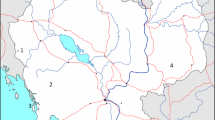Abstract
OVARIAN development in the mosquitoes Aedes (Ochlerotatus) impiger (Walk.) and A. (O.) nigripes (Zett.) has been studied at Hazen Camp, northern Ellesmere Island (71° 18′ W., 81° 49′ N.), a site only 150 miles south of the northernmost limit of land. Both species seek blood actively and, if able to engorge, use it to mature eggs in the usual way. A factor thought to limit their reproductive success is the low availability of blood, resulting from the scarcity of vertebrates and the prevalence of weather inimical to host-seeking during the brief flying season of the mosquitoes.
Similar content being viewed by others
References
Christophers, S. R., Paludism, 2, 73 (1911).
Corbet, P. S., Nature, 203, 668 (1964).
Clements, A. N., The Physiology of Mosquitoes (Pergamon Press, London, 1963).
Spielman, A., Amer. J. Hyg., 65, 404 (1957).
Downes, J. A., Ann. Rev. Entomol., 3, 249 (1958).
Davies, L., Canad. Entomol., 93, 1113 (1961).
Author information
Authors and Affiliations
Rights and permissions
About this article
Cite this article
CORBET, P. Facultative Autogeny in Arctic Mosquitoes. Nature 215, 662–663 (1967). https://doi.org/10.1038/215662a0
Received:
Revised:
Issue Date:
DOI: https://doi.org/10.1038/215662a0
- Springer Nature Limited
This article is cited by
-
Ad libitum consumption of protein- or peptide-sucrose solutions stimulates egg formation by prolonging the vitellogenic phase of oogenesis in anautogenous mosquitoes
Parasites & Vectors (2022)
-
Blood feeding habits of mosquitoes: hardly a bite in South America
Parasitology Research (2022)
-
10.1007/BF00335101
CrossRef Listing of Deleted DOIs (2011)
-
Autogeny in saltmarsh mosquitoes induced by a substance from the male accessory gland
Nature (1977)
-
Survival and Fecundity of Mosquitoes fed on Insect Haemolymph
Nature (1969)





